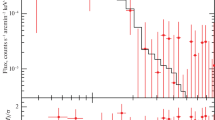Abstract
The detection and identification of distant galaxies is an important goal of observational cosmology, as such galaxies are seen at a time when the Universe was very young. The development of new techniques and instrumentation permits the search for ever-fainter galaxies, and so aids attempts to determine when the first stars and galaxies formed. Here we report the identification of a galaxy at a probable redshift of 6.68, the most distant object yet detected. The galaxy's spectrum is characterized by an abrupt discontinuity at a wavelength λ≈ 9,300 Å, which we interpret as arising from the absorption of light at shorter wavelengths by hydrogen gas along the line of sight (the Lyman-α decrement), and by an emission line at λ≈ 9,334 Å, which we interpret as the Lyman-α line at a redshift of 6.68. The galaxy is relatively bright: the ultraviolet luminosity density contributed by this one galaxy is almost ten times the value measured at z = 3.


Similar content being viewed by others
References
Gardner, J. P. et al. The STIS parallel survey: introduction and first results. Astrophys. J. 492, L99–L102 (1998).
Bertin, E. & Arnouts, S. SExtractor: software for source extraction. Astron. Astrophys. Suppl. 117, 393–404 (1996).
Lanzetta, K. M., Yahil, A. & Fernández-Soto, A. Star-forming galaxies at very high redshifts. Nature 381, 759–763 (1996).
Lanzetta, K. M., Fernández-Soto, A. & Yahil, A. in The Hubble Deep Field, Proc. Space Telescope Science Institute 1997 May Symp.(eds Livio, M., Fall, S. M. & Madau, P.) (Cambridge Univ. Press, in the press).
Fernández-Soto, A., Lanzetta, K. M. & Yahil, A. Anew catalog of photometric redshifts in the Hubble Deep Field. Astrophys. J.(in the press).
Steidel, C. C., Adelberger, K. L., Giavalisco, M., Dickinson, M. & Pettini, M. Lyman break galaxies at z > 4 and the evolution of the UV luminosity density at high redshift. Astrophys. J.(in the press); also as preprint astro-ph/9811399 at 〈http://xxx.lanl.gov〉 (23 January 1999).
Kinney, A. L. et al. Template ultraviolet to near-infrared spectra of star-forming galaxies and their application to K-corrections. Astrophys. J. 467, 38–60 (1998).
Spinrad, H. et al. Asub-galactic pair at z = 5.35. Astron. J. 116, 2617–2623 (1998).
Lowenthal, J. D. et al. Keck spectroscopy of redshift z approximately 3 galaxies in the Hubble deep field. Astrophys. J. 481, 673–688 (1997).
Steidel, C., Giavalisco, M., Pettini, M., Dickinson, M. & Adelberger, K. Spectroscopic confirmation of a population of normal star-forming galaxies at redshifts z > 3. Astrophys. J. 462, L17–L21 (1996).
Madau, P., Pozzetti, L. & Dickinson, M. The star formation history of field galaxies. Astrophys. J. 498, 106–116 (1998).
Acknowledgements
We thank H. Spinrad, and B. Woodgate, B. Hill and the rest of the STIS instrument team for discussions. This work was supported by NASA and the US NSF.
Author information
Authors and Affiliations
Corresponding author
Rights and permissions
About this article
Cite this article
Chen, HW., Lanzetta, K. & Pascarelle, S. Spectroscopic identification of a galaxy at a probable redshift of z = 6.68. Nature 398, 586–588 (1999). https://doi.org/10.1038/19251
Received:
Accepted:
Issue Date:
DOI: https://doi.org/10.1038/19251
- Springer Nature Limited
This article is cited by
-
Close separation triple system QSO 1009-0252 with discordant redshifts: Is the spectrum of one component blueshifted?
Journal of Astrophysics and Astronomy (2009)
-
Evidence against a redshift z > 6 for the galaxy STIS123627+621755
Nature (2000)
-
Unusual spectral energy distribution of a galaxy previously reported to be at redshift 6.68
Nature (2000)
-
A long-distance record breaker
Nature (1999)





